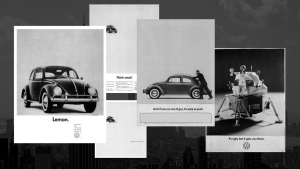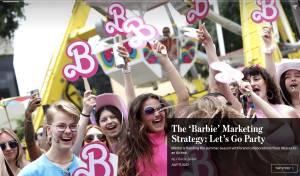Food for Thought
- Most people think Copywriting is Copyrighting
- Copywriting pays well
- Copywriting is writing that persuades – and sometimes sells
My family has never understood what I do for a living. “Copywriting, what’s that” my dad would ask. “Don’t you have to go to law school for that”? 😂
When I tried to explain, my dad grew even more confused. “So you write TV commercials or ads in magazines or on billboards?” Yes, I do – and social media, and more. When a Super Bowl commercial I wrote appeared and made the USA Ten Best list, my dad was impressed. But he still didn’t understand. “I loved your commercial but didn’t see your byline (your name listed as the writer)”. “I’m a copywriter, dad. Not a journalist or screenwriter. It’s a commercial, not an article or film”. 😔

In the end, my dad’s main concern was whether being a copywriter paid well. As it happens, being an ad copywriter pays VERY well. These days, according to Indeed, junior copywriters in NYC earn an average of 60K in an ad agency. In my experience, most junior CWs are able to double their salary within five years. That’s all my dad needed to know.

Like my parents, before you read this book, you probably thought that copywriting is a legal term related to trademarking a product, service, or intellectual property of some sort. But copywriting has nothing to do with the legal profession. Ad agencies and advertisers are nothing like law firms. Read on to find out more.
Copyrighting
Merriam Webster defines copyright as “the exclusive legal right to reproduce, publish, sell, or distribute the matter and form of something (such as a literary, musical, or artistic work)”.
Common examples of copyright infringement include:
- Illegally downloading music files
- Uploading someone else’s copyrighted material to an accessible web page
- Downloading licensed software from an unauthorized site
- Recording a movie in a theater
- Modifying and reproducing someone else’s creative work without making significant changes
In fact, skilled Copywriters “sample” popular culture, tapping into it in their work. But the goal of copywriting is not to copy or plagiarize something. It’s to reflect the consumer’s lived experience in a way that makes them feel “seen”. More about that later…
Copywriting
Copywriting is a very unique kind of writing. A simple definition is: the act of writing words to persuasively sell products, services, or causes. A copywriter is the person who does this.
Here’s a more formal definition of copywriting from Wikipedia: “Copywriting is the act or occupation of writing text for the purpose of advertising or other forms of marketing. The product, called copy or sales copy, is written content that aims to increase brand awareness and ultimately persuade a person or group to take a particular action.” Wikipedia
The best copywriting draws upon popular culture and current trends. It takes something that we’re already aware of and remixes it to make it seem fresh and yet somehow familiar. It evokes some sort of emotion in the consumer, encouraging them to take action.
The Merriam-Webster definition for the noun ‘copy‘ is:
- matter to be set especially for printing
- something considered printable or newsworthy
- text especially of an advertisement
History of Copywriting
How long has copywriting been around? Where did the terms “copy” and “copywriting” come from? How long have they been around? The general consensus is that “Copy” and “copywriting” has existed since Babylonian times and the first printed material is said to have come into the world in 1477, promoting the sale of a prayer book.
In her blog titled “The history and evolution of copywriting” Jones the Writer explains: “The job of a copywriter began by creating ads on a large poster made of paper with a feather dipped ink (how deliciously antiquated and time consuming). These posters were fixed to walls and poles in the bigger cities of Europe. Centuries ago there were no printing processes to make duplicates, so each page was painstakingly handcrafted.
Eventually, the posters evolved to printed pamphlets and brochures. Once mass printing processes were perfected, around 1605, newspapers could be mass produced and hawked on street corners. The first English paper was produced in 1664, called the Oxford Gazette (now known as the London Gazette). It was when the larger format newspapers were published that advertisements began to appear on one full page or several ads were dispersed throughout the pages.”
Fast forward to advertising’s “creative revolution” in the 60s and early 70s when the power of copywriting surged as the notion of brand building emerged. What is brand building? A campaign where a consistent brand idea/story is sustained through many different executions and a variety of media platforms.
US creative Bill Bernbach was the leader, creating startlingly simple press ads for the VW Beetle in the 60s. These copy driven Volkswagen ads, with headlines like “Lemon”, “Think Small”, and “It’s Ugly But It Gets You There”, changed advertising – and the way brands are built – forever.

A current example of brand building is the recent Barbie movie campaign, which created a “pink movement” that resulted in $165 million in box office sales in the U.S. along – $337 million globally so far. The campaign included movie trailers, a social media blitz, and experiential elements like a pink corvette spotted on the streets, a Barbie box you could take photos in at the theater, partnerships with other brands like Crocs, a Malibu Barbie Dreamhouse you could rent on Airbnb and more…

I’m hoping that by now you’re starting to understand that copywriting is unlike any other kind of writing, including technical writing, term paper writing, research, novel writing, screen writing, journalism etc. Copywriting is writing with a purpose; writing that tells a brand story in a way that persuades consumers to think, act and occasionally to buy.
Key Takeaways
- If you decide to be a Copywriter, your family will never understand what you do – but they will be impressed by your salary
- Copywriting has nothing to do with trademarking or protecting intellectual property
- Copywriting has been around since Babylonian times
- Copywriting is a unique form of writing; it persuades consumers to think, act and occasionally to buy
